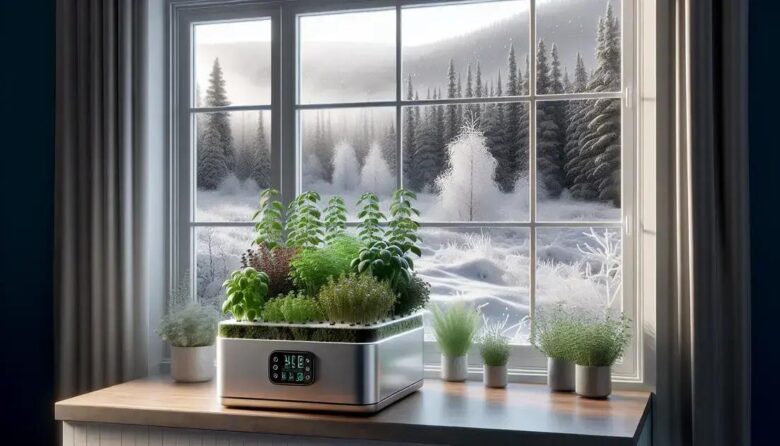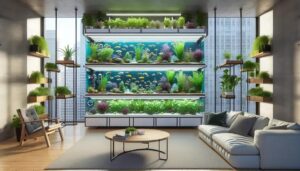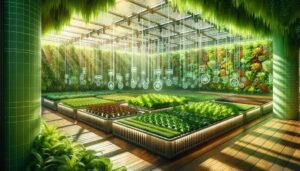Growing herbs in a hydroponic system on your countertop this winter could be easier than you think. Ever wondered how to keep fresh herbs at your fingertips, regardless of the cold season outside? Dive into the world of indoor gardening where you can nurture your favorite plants right in your kitchen. This article will guide you through making your home herb sanctuary.
understanding hydroponic systems for herbs
Hydroponic systems offer a soil-free method of cultivating plants, focusing on providing nutrients directly through water. This is particularly beneficial for growing herbs, as they often require consistent moisture and nutrition to thrive. In hydroponics, the roots are suspended in a nutrient-rich solution, allowing for precise control over nutrient levels and pH balance, ensuring optimal growth conditions all year round.
Types of Hydroponic Systems
There are several types of hydroponic systems suitable for herbs. The nutrient film technique (NFT) uses a shallow stream of water that circulates past the roots. Another popular system is the deep water culture (DWC), where plant roots are submerged in nutrient solution, providing excellent growth rates for leafy herbs.
Advantages of Hydroponic Herb Gardening
One significant benefit of hydroponic gardening is its efficiency. Without soil, the risk of pests and diseases decreases. Additionally, water usage is significantly reduced, as the system allows for recycling unused water. Growing indoors on a countertop means you can have fresh herbs even during winter, turning limited space into a thriving green corner.
For beginners, starting with a simple setup can be an excellent way to learn and gradually expand your indoor garden. Experiment with various herbs like basil, mint, or parsley to determine which grow best under your chosen system’s conditions.
setting up your countertop hydroponic garden
Setting up a countertop hydroponic garden is a rewarding project that brings fresh herbs into your home year-round. Begin by choosing a suitable location on your countertop that is away from direct temperature extremes. Ensure it has access to ample light, either from a nearby window or using grow lights specifically designed for indoor gardening.
Essential Components
A basic hydroponic system includes a water reservoir, air pump, and net pots to hold the plants. The water reservoir stores the nutrient solution, which should be mixed per the instructions for optimal herb growth. An air pump keeps the solution oxygenated, ensuring the roots receive enough air.
Selecting the Right Nutrients
Herbs need a balanced nutrient solution for healthy growth. Choose a formula that provides the essential macronutrients, such as nitrogen, phosphorus, and potassium, along with micronutrients like calcium and magnesium. These solutions are often available in liquid or powder form for ease of use.
After assembling your system, plant the seeds or seedlings in the net pots filled with a growing medium like rockwool or coco coir. Place these pots in the system and ensure they are stable and receiving sufficient light and ventilation.
Regular maintenance is crucial: check the pH levels weekly and adjust as necessary, aiming for a pH of 5.5 to 6.5 for most herbs. Replace the nutrient solution every two weeks to ensure your hydroponic garden remains productive.
best herbs to grow during winter
Growing herbs in a hydroponic system during winter allows you to enjoy fresh flavors despite the cold weather. Certain herbs adapt particularly well to indoor growing conditions, thriving even when temperatures drop outside.
Basil
Basil is a popular choice for indoor cultivation due to its adaptability and vibrant flavor. It grows best in warm conditions with plenty of light, making it ideal for hydroponics with artificial grow lights.
Mint
Mint is another excellent choice. It grows vigorously and requires minimal maintenance, thriving in the consistent conditions offered by hydroponic systems. Its refreshing scent also adds a pleasant aroma to indoor spaces.
Parsley
Parsley can adapt to cooler environments but still prefers consistent warmth and light, making it a suitable candidate for winter hydroponic gardening. It’s packed with nutrients and adds a crisp taste to dishes.
Consider also growing chives, dill, and cilantro. These herbs are resilient and can easily adapt to indoor environments with adequate lighting and proper care.
light and nutrient requirements for indoor herbs
Providing adequate light is crucial for the growth of indoor herbs. Most herbs require at least six to eight hours of light daily, making grow lights a practical solution during the shorter days of winter. Choose LED grow lights for energy efficiency and place them close to your hydroponic system to simulate natural sunlight. It’s important to set timers to mimic consistent daylight hours.
Nutrient Solutions
A balanced nutrient solution is essential for the health of your herbs. This solution should include primary nutrients like nitrogen, phosphorus, and potassium, which contribute to foliage growth and root development. Additionally, micronutrients such as calcium, magnesium, and iron support various plant functions and improve their overall health.
Monitor the nutrient concentration using an EC meter. The ideal range for herbs usually falls between 1.0 to 2.5 mS/cm. Keeping a consistent check ensures that your plants are neither starving nor over-fed.
Maintaining the right pH level is also key. Most herbs prefer a pH between 5.5 to 6.5. Regularly test the water to make necessary adjustments, ensuring nutrient uptake remains efficient.
common challenges and solutions in hydroponic gardening
Despite its many benefits, hydroponic gardening can present various challenges. One common issue is nutrient imbalance, where plants show signs of deficiency or toxicity. Regularly monitor and adjust nutrient levels using an EC meter to ensure that your herbs receive the right balance.
Pest Control
Even indoors, pests can become a problem. To manage them without soil, inspect the plants frequently and use organic pest control methods, such as neem oil or insecticidal soap, to keep them at bay. Maintaining cleanliness around the garden can also prevent pest infestations.
Algae Growth
Algae can grow in reservoirs exposed to light. To prevent algae, cover any openings and ensure the system is light-tight. Regular cleaning of the reservoir and equipment will help minimize algae issues.
System Failures
Equipment failures, such as a pump malfunction, can disrupt water flow and oxygenation, risking root health. Check your system regularly for signs of wear and tear, and have spare parts available to quickly address any failures.
Maintaining a balanced pH can also be tricky, leading to poor nutrient uptake. Test the pH weekly and make adjustments to keep it within the recommended range for your herbs.
maintaining your hydroponic herb garden
Consistent maintenance of your hydroponic herb garden ensures healthy growth and a bountiful harvest. Begin by regularly checking the water level in your system to prevent roots from drying out. Refill the reservoir with fresh nutrient solution every two weeks, ensuring your herbs have all the nutrients they need.
Monitor Plant Health
Inspect your herbs daily for signs of pest damage or nutrient deficiencies. Yellowing leaves might indicate a lack of nitrogen, while spots can signal a fungal issue. Address these problems promptly with appropriate remedies, such as adjusting nutrients or using organic pest controls.
System Upkeep
Keep the system clean to prevent algae and bacteria from accumulating. Regularly clean tubing, filters, and the reservoir, and ensure the water remains oxygenated by checking the air pumps. Replace or clean air stones to maintain a good oxygen flow.
Check the pH level of your nutrient solution weekly. Most herbs thrive in a pH range of 5.5 to 6.5. Adjust as needed using pH up or pH down solutions to maintain optimal growth conditions.
Trimming and harvesting herbs regularly encourages new growth and prevents the plants from becoming too leggy. Use clean scissors to make cuts above leaf nodes to promote bushy growth.
Wrapping up your indoor hydroponic journey
Creating a hydroponic herb garden on your countertop provides a unique way to enjoy fresh herbs throughout the year. By understanding and addressing key aspects such as lighting, nutrient management, and regular maintenance, you can cultivate a thriving garden even in winter.
Through careful selection of herbs that suit indoor environments and troubleshooting common challenges, your indoor garden can flourish, offering a steady supply of flavorsome and aromatic additions to your meals.
So, set up your hydroponic systems and dive into this rewarding gardening method. The process can be both exciting and fruitful, providing benefits that reach beyond your kitchen.
Embrace the joy of indoor gardening and let your countertop become a testament to innovation and sustainability.
FAQ – Common Questions about Indoor Hydroponic Herb Gardening
What are the benefits of growing herbs hydroponically indoors?
Indoor hydroponic systems allow you to grow herbs year-round, reduce pest issues, and provide precise nutrient and water control.
What herbs are best suited for indoor hydroponic systems during winter?
Basil, mint, parsley, chives, dill, and cilantro are well-suited for indoor hydroponic gardens, especially in winter.
How do I maintain the nutrient balance in my hydroponic system?
Regularly check nutrient levels with an EC meter and adjust with the proper nutrient solutions to maintain balance.
How can I prevent algae growth in my hydroponic system?
Keep the system covered to block light from reaching the water and clean the reservoir regularly to reduce algae buildup.
What type of lighting is best for indoor hydroponic herbs?
LED grow lights are efficient and effective for providing the necessary light for indoor herbs, especially in low light conditions.
How often should I clean my hydroponic system?
Clean your system every two weeks or whenever you change the nutrient solution to prevent buildup of algae and bacteria.



